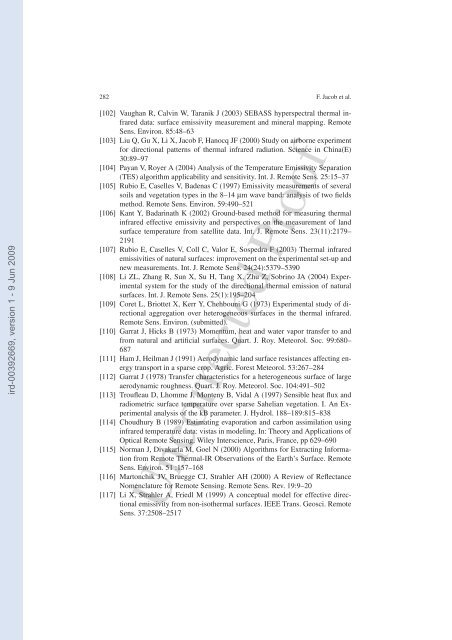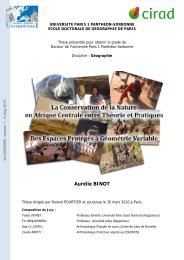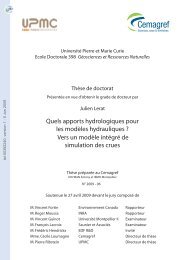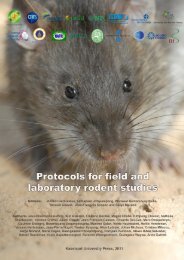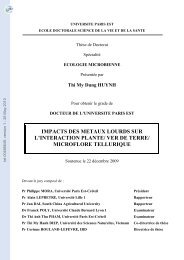Modeling and Inversion in Thermal Infrared Remote Sensing over ...
Modeling and Inversion in Thermal Infrared Remote Sensing over ...
Modeling and Inversion in Thermal Infrared Remote Sensing over ...
You also want an ePaper? Increase the reach of your titles
YUMPU automatically turns print PDFs into web optimized ePapers that Google loves.
282 F. Jacob et al.ird-00392669, version 1 - 9 Jun 2009[102] Vaughan R, Calv<strong>in</strong> W, Taranik J (2003) SEBASS hyperspectral thermal <strong>in</strong>frareddata: surface emissivity measurement <strong>and</strong> m<strong>in</strong>eral mapp<strong>in</strong>g. <strong>Remote</strong>Sens. Environ. 85:48–63[103] Liu Q, Gu X, Li X, Jacob F, Hanocq JF (2000) Study on airborne experimentfor directional patterns of thermal <strong>in</strong>frared radiation. Science <strong>in</strong> Ch<strong>in</strong>a(E)30:89–97[104] Payan V, Royer A (2004) Analysis of the Temperature Emissivity Separation(TES) algorithm applicability <strong>and</strong> sensitivity. Int. J. <strong>Remote</strong> Sens. 25:15–37[105] Rubio E, Caselles V, Badenas C (1997) Emissivity measurements of severalsoils <strong>and</strong> vegetation types <strong>in</strong> the 8–14 µm wave b<strong>and</strong>: analysis of two fieldsmethod. <strong>Remote</strong> Sens. Environ. 59:490–521[106] Kant Y, Badar<strong>in</strong>ath K (2002) Ground-based method for measur<strong>in</strong>g thermal<strong>in</strong>frared effective emissivity <strong>and</strong> perspectives on the measurement of l<strong>and</strong>surface temperature from satellite data. Int. J. <strong>Remote</strong> Sens. 23(11):2179–2191[107] Rubio E, Caselles V, Coll C, Valor E, Sospedra F (2003) <strong>Thermal</strong> <strong>in</strong>fraredemissivities of natural surfaces: improvement on the experimental set-up <strong>and</strong>new measurements. Int. J. <strong>Remote</strong> Sens. 24(24):5379–5390[108] Li ZL, Zhang R, Sun X, Su H, Tang X, Zhu Z, Sobr<strong>in</strong>o JA (2004) Experimentalsystem for the study of the directional thermal emission of naturalsurfaces. Int. J. <strong>Remote</strong> Sens. 25(1):195–204[109] Coret L, Briottet X, Kerr Y, Chehbouni G (1973) Experimental study of directionalaggregation <strong>over</strong> heterogeneous surfaces <strong>in</strong> the thermal <strong>in</strong>frared.<strong>Remote</strong> Sens. Environ. (submitted).[110] Garrat J, Hicks B (1973) Momentum, heat <strong>and</strong> water vapor transfer to <strong>and</strong>from natural <strong>and</strong> artificial surfaces. Quart. J. Roy. Meteorol. Soc. 99:680–687[111] Ham J, Heilman J (1991) Aerodynamic l<strong>and</strong> surface resistances affect<strong>in</strong>g energytransport <strong>in</strong> a sparse crop. Agric. Forest Meteorol. 53:267–284[112] Garrat J (1978) Transfer characteristics for a heterogeneous surface of largeaerodynamic roughness. Quart. J. Roy. Meteorol. Soc. 104:491–502[113] Troufleau D, Lhomme J, Monteny B, Vidal A (1997) Sensible heat flux <strong>and</strong>radiometric surface temperature <strong>over</strong> sparse Sahelian vegetation. I. An Experimentalanalysis of the kB parameter. J. Hydrol. 188–189:815–838[114] Choudhury B (1989) Estimat<strong>in</strong>g evaporation <strong>and</strong> carbon assimilation us<strong>in</strong>g<strong>in</strong>frared temperature data: vistas <strong>in</strong> model<strong>in</strong>g. In: Theory <strong>and</strong> Applications ofOptical <strong>Remote</strong> Sens<strong>in</strong>g. Wiley Interscience, Paris, France, pp 629–690[115] Norman J, Divakarla M, Goel N (2000) Algorithms for Extract<strong>in</strong>g Informationfrom <strong>Remote</strong> <strong>Thermal</strong>-IR Observations of the Earth’s Surface. <strong>Remote</strong>Sens. Environ. 51 :157–168[116] Martonchik JV, Bruegge CJ, Strahler AH (2000) A Review of ReflectanceNomenclature for <strong>Remote</strong> Sens<strong>in</strong>g. <strong>Remote</strong> Sens. Rev. 19:9–20[117] Li X, Strahler A, Friedl M (1999) A conceptual model for effective directionalemissivity from non-isothermal surfaces. IEEE Trans. Geosci. <strong>Remote</strong>Sens. 37:2508–2517Uncorrected Proof


